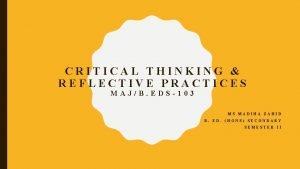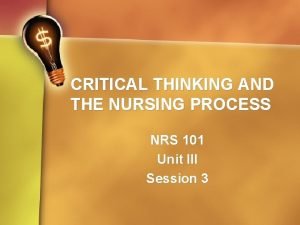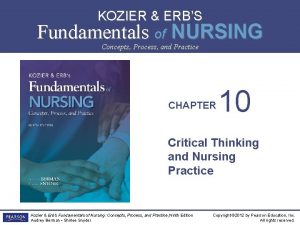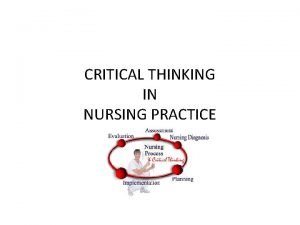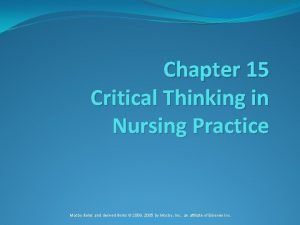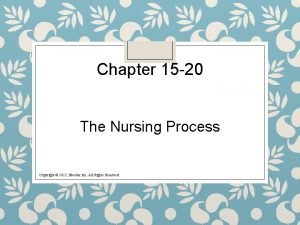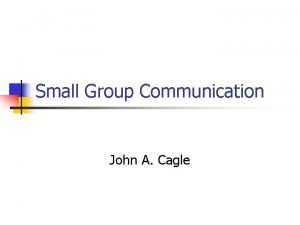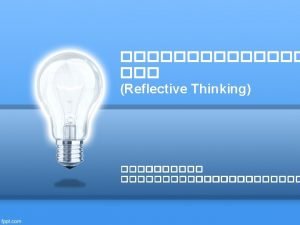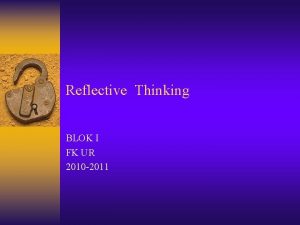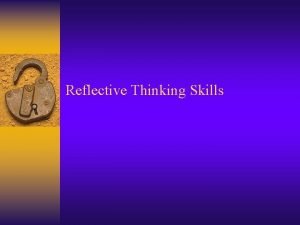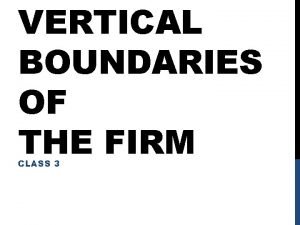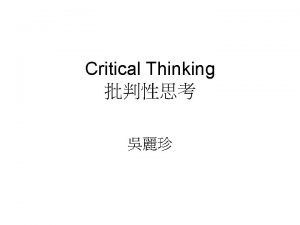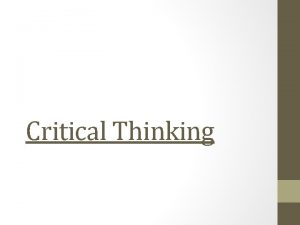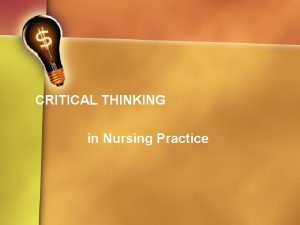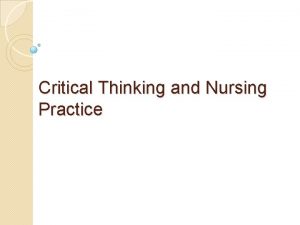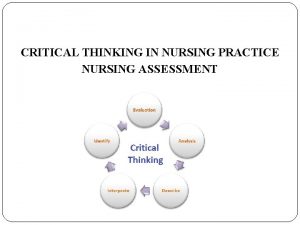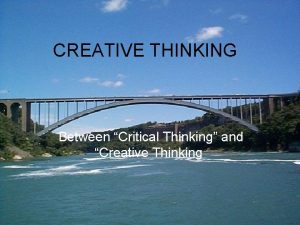MEASURING UNDERGRADUATE NURSING STUDENTS REFLECTIVE THINKING AND CRITICAL
















- Slides: 16

MEASURING UNDERGRADUATE NURSING STUDENTS’ REFLECTIVE THINKING AND CRITICAL REFLECTION SELFEFFICACY FOLLOWING HIGH FIDELITIY SIMULATION: A PILOT STUDY Naomi Tutticci, BN, M Ed. Studies Associate Professor Peter A. Lewis, BN Cert. CC MN. Ed Ph. D Professor Fiona Coyer, RN, PGCEA, MN, Ph. D

How to become a reflective giant It’s not so much of a mystery…. .

What does the literature say? Critical thinking = essential graduate generic skill (Facione & Facione, 1996) Critical reflection = metacognitive skill, underpinning critical thinking (Gul et al. , 2010) HFS can enhance critical thinking, clinical skill performance and knowledge acquisition (Lapkin et al. , 2010) HFS builds confidence (Jefferies & Rizzolo, 2006) Self efficacy important to evaluate in simulation context (Sinclair & Ferguson, 2009)

Lack of instruments to measure: • reflective thinking and its extent, after HFS • self-belief about one’s capacity to critically reflect Where’s the gate?

Study questions The research questions were: 1) Does the Reflective Thinking instrument and Critical Reflection Self-Efficacy VAS demonstrate content validity? 2) What is the reliability of the Reflective Thinking and Simulation Survey?

Research design This pilot study is divided into two phases: Phase one individual ‘think aloud’ sessions expert panel to address the validity measures: the reflective thinking instrument and critical reflection self-efficacy visual analogue scale (VAS). Phase two post-test only design

Setting and sample Metropolitan Australian university’s school of nursing offering: a Bachelor of Nursing (BN) program and three double degrees nursing/behavioral science nursing/paramedic science nursing/public health HFS laboratories located onsite August - September 2014

Instrument The phase two survey was comprised of 5 instruments, demographic questions and an open-ended question. 1. 2. 3. 4. 5. Reflective Thinking instrument (Kember at al. , 2000) Critical Reflection Self-efficacy Visual Analogue Scale General Self-Efficacy Scale (Schwarzer & Jerusalem, 1995) The Educational Practices in Simulation Scale (Jefferies and Rizzolo, 2006) Satisfaction with Simulation Experience Scale (Levett-Jones et al. , 2011)

Procedure Phase one Individual ‘think aloud’ sessions Content validation by expert panel: 6 academics Expertise in HFS, curriculum and instrument design and international students

Procedure Phase two Electronic surveys - an online link using Key Survey v 8. 2 Survey remained open for two weeks once the final clinical subject’s simulations had been completed

Data analysis – phase one & two Phase one Verbatim comment analysed and grouped Items commented on and rated by expert panel Content Validity Index (CVI) or S-CVI/Ave Phase two Internal consistency using Cronbach’s alpha Verbatim comments analysed and grouped

Results – phase one ‘Think Aloud’ 6 students (5 female/1 male) Responses sorted into three groups 1. ‘thinking reflectively’ 2. Simulation equates to clinical practice 3. Simulation specific Ø Overall simulation considered a type of clinical practice Expert Panel S-CVI/Ave = 0. 90 No items rejected by panel – comments resulted in eight changes to items

Results – phase two Fifty eight third year students (25%) participated in phase two Reflective Thinking instrument - internal consistency: Habitual action . 701 Understanding . 682 Reflection . 608 Critical reflection . 808 Critical Reflection Self-Efficacy VAS and General Self-Efficacy small to medium positive correlation (r =. 324, n = 56, p = . 048)

Discussion and the benefit of hindsight Content valid and internally consistent instruments Measure reflective thinking and self efficacy Transferability of competence from simulation to real clinical practice Simulation type of clinical practice Scale missing ‘not applicable’ Small to medium correlation What I wouldn’t have done then, knowing what I know now! Removal of item 3

Thank you and questions

. References Facione, N. C. & Facione, P. A. (1996). Externalizing the Critical Thinking in Knowledge Development and Clinical Judgment. Nursing Outlook, 44, 129 -136. Gul, R. , Cassum, S. , Ahmad, A. , Khan, S. , Saeed, T & Parpio, Y. (2010). Enhancement of critical thinking in curriculum design and delivery: A randomised controlled trial for educators. Procedia Social and Behavioural Sciences, 2, 3219 -3225. Jefferies, P. R. , & Rizzolo, M. A. (2006). Designing and implementing models for the innovative use of simulation to teach nursing care of ill adults and children: A national, multi-site, multi-method study. New York: National League for Nursing. Kameg, K. , Mitchell, A. , Clochesy, J. , Howard, V. , & Suresky, J. (2009). Communication and human patient simulation in psychiatric nursing. Issues In Mental Health Nursing, 30(8), 503 -508. doi: 10. 1080/01612840802601366 Kember, D. , Leung, D. P. , Jones, A. , Loke, A. , Mc. Kay, J. , Sinclair, K. , &. . . Yeung, E. (2000). Development of a Questionnaire to Measure the Level of Reflective Thinking. Assessment & Evaluation In Higher Education, 25(4), 381 -395. doi: 10. 1080/026029300449272 Lapkin, S. , Levett-Jones, T. , Bellchambers, H. , & Fernandez, R. (2010). Effectiveness of patient simulation manikins in teaching clinical reasoning skills to undergraduate nursing students: A systematic review. Clinical Simulation in Nursing, 6(6), e 207 -e 222. doi: 10. 1016/j. ecns. 2010. 05. 005 Levett-Jones, T. , Mc. Coy, M. , Lapkin, S. , Noble, D. , Hoffman, K. , Dempsey, J. , Arthur, C. & Roche, J. (2011). The development and psychometric testing of the Satisfaction with Simulation Experience Scale. Nurse Education Today, 31, 705 -710 Schwarzer, R & Jerusalem, M. (1995). The General Self-Efficacy Scale. Retrieved January 7, 2004, from http: //userpage. fuberlin. de/~health/engscal. htm Sinclair, B. & Ferguson, K. (2009). Integrating Simulated Teaching/Learning Strategies in Undergraduate Nursing Education. International Journal of Nursing Education Scholarship, 6(1), pp. -. Retrieved from doi: 10. 2202/1548 -923 X. 1676
 Critical thinking and reflective practices
Critical thinking and reflective practices Critical semi critical and non critical instruments
Critical semi critical and non critical instruments Spaulding classification of medical devices ppt
Spaulding classification of medical devices ppt Perbedaan critical thinking dan creative thinking
Perbedaan critical thinking dan creative thinking Medical diagnosis and nursing diagnosis difference
Medical diagnosis and nursing diagnosis difference Critical thinking and the nursing process
Critical thinking and the nursing process Nursing inferences examples
Nursing inferences examples Importance of critical thinking in nursing process
Importance of critical thinking in nursing process Fundamentals of nursing chapter 15 critical thinking
Fundamentals of nursing chapter 15 critical thinking Fundamentals of nursing chapter 15 critical thinking
Fundamentals of nursing chapter 15 critical thinking Physical development in adulthood
Physical development in adulthood John dewey’s reflective thinking model
John dewey’s reflective thinking model Types of reflective thinking
Types of reflective thinking Reflective thinking adalah
Reflective thinking adalah What is reflective thinking
What is reflective thinking How to get an academic writing account
How to get an academic writing account Portland state university tuition
Portland state university tuition
